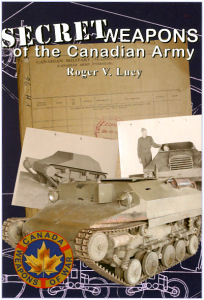
Secret Weapons of the Canadian Army Book Review
By Cookie Sewell
| Date of Review | October 2006 | Title | Secret Weapons of the Canadian Army |
|---|---|---|---|
| Author | Roger V. Lucy | Publisher | Service Publications |
| Published | 2006 | ISBN | 1-894581-40-7 |
| Format | 128 pages, softbound | MSRP (CDN) | $29.95 |
Review
When I opened the packet that the review copy of this book came in, my first impression was "yeah, right, and the next one will cover Guatemalan Atomic Secrets!" It is something of a misnomer, as what the book actually provides is a very good listing of all of the Canadian efforts to contribute to Commonwealth and Allied scientific developments in ground arms during WWII.
Canada had some problems during WWII due to its location and trading partners. By culture, government and forces it was linked to the United Kingdom, as it was still an integral part of the Empire at the time albeit with virtual self-government. However, industrially it was tightly linked to the United States, and many Canadian companies were offshoots of American ones (Ford, Chevrolet and the best known one of all, the Montreal Locomotive Works or MLW, which was the Canadian branch of the famous American Locomotive Company – ALCO.) As such the Canadians were caught in the middle: generally armed with British pattern weaponry and trained in the British mold, but with industries better suited to produce American weapons.
The individual responsible for Canadian war materiel production was the Master General of Ordnance or MGO Branch, and all of the programs flowed through this office. As such, they received a number of requests both directly from Canadian forces and from the War Office in the UK for specific items, all of which they tried to meet.
The book covers a host of systems – roughly 70 different systems broken down as infantry weapons, antitank weapons, self-propelled artillery, mines, antiaircraft weapons, artillery, combat vehicles, tracked vehicles, miscellaneous items, and tank-based projects. Where the weapons system did make it into production, such as with the M3-derived Ram cruiser tank and the Sexton 25-pdr SP gun, only minimal mention is made of the system (as it is better covered in other Service publications.)
Some of the weapons seem logical, such as rechambering the Bren Gun to fire the US standard .30-06 rimless cartridge (which was successful but considered irrelevant by the end of the war.) Some were marginal, such as trying to upgrade the 2-pdr antitank gun to deal with modern German armor.
There are also some really bizarre ones, which seem somewhat incredulous but still show there was an "NIH" syndrome at work in the UK. One case in point was the concept of converting the US M10 3" GMC tank destroyer to take the British 17-prd antitank gun. The US could not send them a complete M10, so they sent the plans to MLW and they took a Ram (M3) hull and with minor changes produced an early model M10 from it. Theirs worked a bit better as it kept the air-cooled radial engine of the M3/M4 series tanks, but suffered the same problems with overbalanced gun.
While that was felt to be a solvable problem, the idea of installing the 17-pdr was more of a challenge. One officer did some work and showed that a simple boring down of the rear 17 inches of the gun barrel in front of the breech by 5mm, which would not harm its reliability, would then permit it to be installed easily and quickly in the existing 3" mount. The British ignored the idea and instead went through a number of unsuccessful concepts, with the result that it took too long to get what would have been a valuable weapon into service.
Overall this is an excellent little book, and if nothing else proves that Canada was more than an unassailable production adjunct to Britain.
Thanks to Clive Law of Service Publications for the review copy.







